Study on the Decoupling Effect and Driving Factors of Tourism Transportation Carbon Emissions in the Yangtze River Delta Region
Abstract
1. Introduction
- (1)
- Emission accounting method: Current approaches to quantifying tourism transportation emissions bifurcate into top-down and bottom-up methods. Top-down models, such as energy-statistics-based coefficient systems (Becken [4], 2003; Wei, Y [5], 2012) and input-output frameworks (Perch [6], 2010), offer macro-level efficiency but lack spatiotemporal granularity. Conversely, bottom-up techniques leveraging activity data and GIS trajectory tracking (Diaz Perez [7], 2019; Hu, C [8], 2022; Liu, J [9], 2024) enhance resolution but face challenges in system boundary consistency. Hybrid lifecycle assessments (Liao, H [10], 2022) have emerged to reconcile these trade-offs, yet their application remains limited to single-region studies. A notable gap lies in the absence of standardized methodologies for cross-provincial urban agglomerations, where spatial spillovers and policy coordination complexities are pronounced.
- (2)
- Decoupling effect analysis: In the study of the relationship between economic growth and environmental stress, the decoupling model represented by OECD (Lundquist [11], 2021) and Tapio frameworks plays a dominant role [12]. The Tapio model, with its dimensionless flexibility (Liu, F [13], 2022; Wang, Z [14], 2022), has been widely adopted to categorize decoupling states. However, existing studies predominantly focus on national or provincial scales, overlooking intra-regional heterogeneity within integrated urban clusters like the Yangtze River Delta. Furthermore, while IPAT-derived analyses (Lu, Z [15], 2007) evaluate environmental load–economic growth linkages, few integrate decoupling metrics with spatiotemporal evolution patterns, limiting their utility in policy formulation for dynamic regions.
- (3)
- Driving mechanism exploration: Drivers of tourism transportation emissions are increasingly analyzed through decomposition techniques (e.g., LMDI, Kaya identity) (Cansino [16], 2015; Moutinho [17], 2018; Wang, L [18], 2023) and extended STIRPAT models. Spatial heterogeneity studies (Tiwari [19], 2013; Sun, Y [20], 2020) highlight regional disparities in emission intensity reduction paths, yet fail to address cross-city synergistic mechanisms. Innovations such as panel VAR models (Li, Y [21], 2022) reveal lag effects between emissions and growth but neglect emerging factors like cultural tourism integration. (Ghazali [22], 2019; Pham [23], 2020; Su, H [24], 2024) underscore the catastrophic potential of tourism consumption–energy structure interactions, yet regulatory variables (e.g., institutional quality, cross-regional collaboration) remain underexplored.
2. Materials and Methods
- (1)
- Data integration and carbon emission accounting
- (2)
- Construction of dynamic association model
- (3)
- Drive mechanism analysis
2.1. Carbon Emission Measurement Model of Tourism Transportation
2.2. Decoupling Model
2.3. Spatial Analysis Method
2.4. Selection and Analysis of Influencing Factors
2.4.1. Index Selection
2.4.2. Kaya Identity and LMDI Decomposition Model
2.4.3. Grey Correlation Analysis Method
2.5. Source of Data
3. Results
3.1. Temporal and Spatial Evolution Characteristics
3.1.1. Temporal Evolution Characteristics of Tourism Transportation Carbon Emissions in the Yangtze River Delta Region, 2000–2022
- (1)
- Regional level
- (2)
- Provincial and municipality level
3.1.2. Spatial Evolution Characteristics of Tourism Transportation Carbon Emissions in the Yangtze River Delta Region, 2000–2022
- (1)
- In 2000, the carbon emissions of tourism transportation in the Yangtze River Delta showed a spatial distribution characteristic of “high in the east and low in the west”. The Shanghai metropolitan area, capital cities (except Hefei) and coastal cities have relatively high carbon emissions, while the western region of the Yangtze River Delta, including cities such as Hefei and Lu’an, had low carbon emissions.
- (2)
- In 2005, the spatial distribution shifted to “higher in the middle and lower in the west.” While high-carbon emission areas remained largely the same, some cities in Jiangsu and Zhejiang provinces, such as Xuzhou, Yancheng, and Taizhou, transitioned from high-carbon to low-carbon emission areas.
- (3)
- In 2010, the spatial distribution pattern resembled that of 2000 but at a higher emission level for most cities. By 2015, the carbon emissions from tourism transportation in the Yangtze River Delta followed a “low in the north and south, high in the middle” pattern.
- (4)
- In 2020, 36 cities in the Yangtze River Delta, excluding Shanghai and its neighboring city Suzhou, as well as the two provincial capitals and Xuzhou, were classified as low-carbon emission zones. The spatial distribution in 2022 was similar to that of 2020, except for Xuzhou, which further transitioned from a medium-carbon emission zone to a low-carbon emission zone after implementing a series of emission reduction measures.
3.2. Decoupling Effect Analysis
3.2.1. Analysis of the Relative Relationship and Decoupling Effect Between Tourism Transportation Carbon Emissions and Tourism Economy in the Yangtze River Delta Region
3.2.2. Analysis of Regional Differences in Decoupling Effect
3.2.3. Environmental Kuznets Curve (EKC) Verification
- (1)
- Results of unit root test and cointegration test
- (2)
- Granger causality test based on the VAR model
- (3)
- EKC regression verification
3.3. Analysis of Influencing Factors of Carbon Emissions from Tourism and Transportation in the Yangtze River Delta Region, 2000–2022
3.3.1. LMDI Decomposition and Analysis of Influencing Factors of Tourism and Transportation Carbon Emissions in the Yangtze River Delta Region
3.3.2. Grey Correlation Analysis of Influencing Factors
- (1)
- Tourist Scale: The tourist flow to cultural facilities is the strongest positive driving factor for carbon emissions, with a correlation degree of 0.925. The number of tourists in the Yangtze River Delta increased by 651.27% from 2000 to 2022. The scale of passenger flow in A-class scenic spots has a correlation degree of 0.876 and only slightly promoted carbon emissions due to the adoption of green transportation methods.
- (2)
- Economic Structure: The proportion of the tourism economy is the main inhibiting factor, with a correlation degree of 0.893 and a contribution value of −215.876. Tourism revenue increased by 900% from 2000 to 2022. GDP (correlation degree 0.865) and economic share of services (correlation degree 0.837) were the main contributing factors to carbon emissions.
- (3)
- Energy Transformation: The energy structure’s contribution value, with a correlation degree of 0.884, was −50.36. This contribution turned positive in the later period, indicating significant potential for optimizing the energy structure.
- (4)
- Innovation-Driven: Efficiency of educational resource allocation (correlation degree 0.881) and the contribution rate of the innovation economy (correlation degree 0.869) are positive factors, while the ratio of investment in services to output (correlation degree 0.86) serves as an inhibitory factor.
- (5)
- Consumption Demand: The per capita tourism consumption level has a contribution value of 17.11 and a correlation degree of 0.845. This factor weakly promoted carbon emissions, reflecting a balanced demand between consumption upgrading and low-carbon transformation.
4. Conclusions and Policy Recommendations
4.1. Conclusions
- (1)
- Dynamic spatiotemporal evolution law: The carbon emissions of tourism transportation in the Yangtze River Delta experience three stages of “growth, fluctuation, and decline”, and spatial differentiation is significantly affected by the economic gradient and transportation infrastructure. The radiation effect of Shanghai, as the core emission pole, must be paid attention to.
- (2)
- Nonlinear characteristics of decoupling: Weak decoupling dominance reflects the insufficient effectiveness of current emission reduction policies, and the inflection point of the inverted U-shaped curve lags behind the pace of regional economic transformation, suggesting the need to strengthen structural regulation.
- (3)
- Synergy of driving factors: The expansion of economic scale is still the main reason for the growth of carbon emissions, but the integration of culture and tourism shows significant emission reduction potential through the regulation of passenger flow (such as low-carbon diversion of cultural facilities), which confirms the feasibility of the collaborative path of “consumption upgrading—technology substitution”.
4.2. Policy Suggestions
- (1)
- Accelerating the optimization of the energy mix: Aiming to reduce emissions through the electrification of public transport and the adoption of renewable energy sources, this measure has significant immediate mitigation potential. Considering that challenges such as the high cost of investment in new energy transportation infrastructure and financial constraints in small and medium-sized cities may arise, the government can set up a special fund for green transportation in the region in the future and implement stepped subsidies for small and medium-sized cities (such as increasing subsidies by 50% for cities with carbon intensity below 20% of the average level).
- (2)
- Establish a cross-city carbon offsetting mechanism: establish a “carbon budget-carbon quota” mechanism to incorporate emission reduction performance into official government assessments. Build a “carbon budget-cap-and-trade” platform, incorporate the inter-provincial emission gap (for example, the carbon emission intensity ratio between Shanghai and Anhui is 3.2:1) into the government performance assessment, promote the planning of high-speed rail network and direct connection lines between scenic spots, and alleviate the pressure on core hubs.
- (3)
- Cultural and tourism integration low-carbon practice: Learn from Japan’s “cultural heritage + shared transportation” model, design Jiangnan Ancient Town cycling corridor and other low-carbon cultural and tourism products, create a cycling route connecting ancient towns and cultural sites, and establish a “low-carbon cultural and tourism certification” system through digital platforms to achieve cross-district points exchange (such as “one code pass” app), guide tourists’ behavior transformation.
4.3. Research Deficiencies and Prospects
Author Contributions
Funding
Institutional Review Board Statement
Informed Consent Statement
Data Availability Statement
Conflicts of Interest
References
- Yang, Y.; Wang, H.; Loeschel, A.; Zhou, P. Patterns and determinants of carbon emission flows along the Belt and Road from 2005 to 2030. Ecol. Econ. 2022, 192, 107260. [Google Scholar] [CrossRef]
- Zhong, Z.; Chen, Y.; Fu, M.; Li, M.; Yang, K.; Zeng, L.; Liang, J.; Ma, R.; Xie, Q. Role of CO2 geological storage in China’s pledge to carbon peak by 2030 and carbon neutrality by 2060. Energy 2023, 272, 127165. [Google Scholar]
- Zeng, Q.; He, L. Study on the synergistic effect of air pollution prevention and carbon emission reduction in the context of “dual carbon”: Evidence from China’s transport sector. Energy Policy 2023, 173, 113370. [Google Scholar] [CrossRef]
- Becken, S.; Simmons, D.G.; Frampton, C. Energy use associated with different travel choices. Tour. Manag. 2003, 24, 267–277. [Google Scholar]
- Wei, Y.X.; Sun, G.N.; Ma, L.J.; Li, J. Preliminary estimation of carbon emissions from tourism transportation and regional differences in China. J. Shaanxi Norm. Univ. Nat. Sci. Ed. 2012, 40, 76–84. [Google Scholar]
- Perch-Nielsen, S.; Sesartic, A.; Stucki, M. The greenhouse gas intensity of the tourism sector: The case of Switzerland. Environ. Sci. Policy 2010, 13, 131–140. [Google Scholar]
- Dķaz Pérez, F.J.; Chinarro, D.; Guardiola Mouhaffel, A.; Dķaz Martķn, R.; Pino Otķn, M.R. Comparative study of carbon footprint of energy and water in hotels of Canary Islands regarding mainland Spain. Environ. Dev. Sustain. 2018, 21, 1763–1780. [Google Scholar] [CrossRef]
- Hu, C.; Ding, Z.S.; Mu, X.Q.; Guo, X.Y.; Du, Z.J. Spatial and temporal evolution of carbon emissions from tourism traffic in the Yangtze River Economic Belt and the driving factors. J. Nanjing Norm. Univ. (Nat. Sci. Ed.) 2022, 45, 40–48. [Google Scholar]
- Liu, J.H.; Liu, Y.X.; Huang, L. Measurement of carbon emissions from tourism transport and analysis of driving factors in East China. Res. Environ. Sci. 2024, 37, 626–636. [Google Scholar] [CrossRef]
- Liao, H.Y.; Zhao, M.; Li, Y.X. A high spatial resolution CO2 emission inventory in Beijing. Clim. Change Res. 2022, 18, 188–195. [Google Scholar]
- Lundquist, S. Explaining events of strong decoupling from CO2 and NOx emissions in the OECD 1994–2016. Sci. Total Environ. 2021, 793, 148390. [Google Scholar] [CrossRef] [PubMed]
- Liu, J.Y.; Xie, J. Environmental regulation and export quality upgrading of manufacturing industry—A perspective based on heterogeneity of factor input structure. China’s Popul. Resour. Environ. 2018, 28, 158–167. [Google Scholar]
- Liu, F.; Kang, Y.; Guo, K. Is electricity consumption of Chinese counties decoupled from carbon emissions? A study based on Tapio decoupling index. Energy 2022, 251, 123879. [Google Scholar] [CrossRef]
- Wang, Z.; Lv, D. Analysis of Agricultural CO2 Emissions in Henan Province, China, Based on EKC and Decoupling. Sustainability 2022, 14, 1931. [Google Scholar] [CrossRef]
- Lu, Z.W. Quantitative relationship between environmental load of economic growth. Environ. Prot. 2007, 7, 13–18. [Google Scholar] [CrossRef]
- Cansino, J.M.; Sįnchez-Braza, A.; Rodrķguez-Arévalo, M.L. Driving forces of Spain’s CO2 emissions: A LMDI decomposition approach. Renew. Sustain. Energy Rev. 2015, 48, 749–759. [Google Scholar] [CrossRef]
- Moutinho, V.; Madaleno, M.; Inglesi-Lotz, R.; Dogan, E. Factors affecting CO2 emissions in top countries on renewable energies: A LMDI decomposition application. Renew. Sustain. Energy Rev. 2018, 90, 605–622. [Google Scholar] [CrossRef]
- Wang, L.G.; Zhu, H. Multi-scenario Evolution of Tourism Carbon Emissions in Jiangxi Province under the “Carbon Peak and Neutrality” Target. J. Resour. Ecol. 2023, 14, 265–275. [Google Scholar]
- Tiwari, P.; Gulati, M. An analysis of trends in passenger and freight transport energy consumption in India. Res. Transp. Econ. 2013, 38, 84–90. [Google Scholar] [CrossRef]
- Sun, Y.Y. Estimation of CO2 Emission and Its Effect Decomposition in Tourism Sector of Shanghai City. Areal Res. Dev. 2020, 39, 122–126. [Google Scholar]
- Li, Y.H. Relationship Among Energy Consumption, Economic Growth and Carbon Emission in China Based on PVAR Model. Coal Econ. Res. 2022, 42, 22–29. [Google Scholar]
- Ghazali, A.; Ali, G. Investigation of key contributors of CO2 emissions in extended STIRPAT model for newly industrialized countries: A dynamic common correlated estimator (DCCE) approach. Energy Rep. 2019, 5, 242–252. [Google Scholar]
- Pham, N.M.; Huynh, T.L.D.; Nasir, M.A. Environmental consequences of population, affluence and technological progress for European countries: A Malthusian view. J. Environ. Manag. 2020, 260, 110143. [Google Scholar] [CrossRef] [PubMed]
- Su, H.M.; Zhang, C.B.; Wang, C.X.; Han, L.P. Analysis of the impact path of green technology spillovers on the carbon emission intensity of the coal industry in Shanxi, Shaanxi and Inner Mongolia. China Coal 2024, 50, 27–38. [Google Scholar]
- Zhong, Z.Q.; Wu, J.; Xu, A.W.; Wei, M.; Wang, Z. Preliminary estimation of CO2 emission of tourism industry and its regional difference in China. World Reg. Stud. 2016, 25, 83–94. [Google Scholar]
- Wang, K.; Shao, H.Q.; Zhou, T.T.; Liu, H.L. Analysis of influencing factors of carbon emissions from tourism industry in China based on STIRPAT model. Acta Sci. Circumstantiae 2017, 37, 1185–1192. [Google Scholar]
- Peeters, P.; Dubois, G. Tourism travel under climate change mitigation constraints. J. Transp. Geogr. 2010, 18, 447–457. [Google Scholar]
- Fan, J.Q.; Zhu, Y. On Decoupling Analysis of Tourism Economy and Measurement of Carbon Emissions from Tourism Transportation: A Case Study of Five Provinces (regions) in Northwestern China. Sci. Technol. Manag. Land Resour. 2024, 41, 1–14. [Google Scholar]
- Liao, H.L. Study on the Influence Mechanism of Tourism Transportation Carbon Emission on Residents’ Health in Six Provinces of Central China; Hunan Normal University: Changsha, China, 2019. [Google Scholar]
- Cai, G.Q.; Wang, L.N.; Li, M.N.; Zhang, Q.Y.; Wang, Y.T. Study on driving mechanism of carbon emission of tourism transportation in Hainan Province. Energy Environ. 2022, 5, 10–13. [Google Scholar]
- Li, Y. Analysis on Carbon Emissions of Tourism Traffic and Its Influencing Factors in Anhui. J. Environ. Manag. Coll. China 2018, 28, 50–53. [Google Scholar]
- Ding, L.J.; Zhu, Y.L. Regional differences and decoupling effects of carbon emissions from China’s transport industry. Southeast Acad. Res. 2023, 4, 162–174. [Google Scholar] [CrossRef]
- Hu, H.; Zhang, J.H.; Yang, M.; Kang, J.Y.; Sun, J.K. Estimation and dynamic change of regional tourism carbon emissions: A case study of Jiangsu Province. Ecol. Econ. 2016, 32, 57–62. [Google Scholar]
- Jiao, G.Y.; Zheng, Y.T.; Ye, Q. Temporal and spatial distribution characteristic of energy consumption and CO2 emission by tourism industry of Jiangxi province. J. Cent. South Univ. For. Technol. 2012, 32, 105–112. [Google Scholar]
- Wang, J.; Xue, J.J. Estimation of carbon emissions from tourism and transportation and analysis of influencing factors. Stat. Decis. 2016, 13, 61–64. [Google Scholar] [CrossRef]
- Kuo, N.; Chen, P. Quantifying energy use, carbon dioxide emission, and other environmental loads from island tourism based on a life cycle assessment approach. J. Clean Prod. 2009, 17, 1324–1330. [Google Scholar] [CrossRef]
- Li, X.J.; Ceng, B.W.; Zhang, H.; Song, Z.Q.; Yang, Y.; Ma, B.; Sun, J.X.; Ye, C.; Zhu, H.; Zhang, S.M.; et al. New Quality Productive Forces and High-quality Development in Tourism: Problems, Cognition and Optimization Direction. Tour. Trib. 2024, 39, 15–29. [Google Scholar]
- Guo, W.Q.; Yu, Z.P.; Lei, M.; Zhang, W.P.; Gao, Y.Q. Decomposition of Carbon Emission Drivers and Decoupling Effort Effects in China. Res. Environ. Sci. 2025, 38, 209–219. [Google Scholar]
- Yin, X.H.; Li, X. Re-study on Calculation and Decomposition Methods of Gini Coefficient. Stat. Decis. 2025, 41, 47–51. [Google Scholar]
- Li, Q.G.; Nie, P.; Xu, B.Y.; Peng, X. Inequality of Opportunity in Income and the Mental Health of Chinese Residents. Popul. Dev. 2025, 31, 70–79. [Google Scholar]
- Guo, X.Y.; Mu, X.Q.; Ming, Q.Z.; Ding, Z.S. Analysis of carbon emission pattern and influencing factors of tourism transportation in China. Geogr. Geo-Inf. Sci. 2022, 38, 129–136. [Google Scholar]
- Ma, H.Q.; Liu, J.L.; Gong, Z.G. Carbon Emission and Evolution Mechanism of Tourism Transportation in Shanxi Province. Econ. Geogr. 2019, 39, 223–231. [Google Scholar]
- Huang, H.P.; Qiao, X.Z.; Zhang, J.; Li, Y.L.; Ceng, Y.M. Spatio-Temporal Differentiation and Influencing Factors of Regional Tourism Carbon Emissions under the Background of Green Development: A Case Study of the Yangtze River Economic Belt. Econ. Geogr. 2019, 39, 214–224. [Google Scholar]
- Wang, Z.F.; Shi, W.J.; Su, C.G. Spatial Pattern of Health Tourism Destination in China and Its Influence Factors. Econ. Geogr. 2020, 40, 196–207. [Google Scholar]
- Hu, F.; Li, Y.B. Research on the Low-Carbon Transition Mode of Tourism Industry in Ethnic Areas Based on the System Dynamics Model. Ecol. Econ. 2024, 40, 135–142. [Google Scholar]
- Pan, Q.L.; Song, Y.Q.; Chen, L.; Pan, Z.K. Spatial pattern and influencing factors of county tourism efficiency in Shaanxi Province. J. Nat. Resour. 2021, 36, 866–878. [Google Scholar] [CrossRef]
- Fu, X.Y.; Huang, T.Z. Grey correlation analysis of influencing factors of tourism economy in Inner Mongolia. Stat. Decis. 2015, 3, 142–145. [Google Scholar] [CrossRef]
- Wang, Q.L.; Jin, X.L. Analysis of the Spatial Structure Evolution and its Influence Factors of A-grade Tourist Scenic Area in Anhui Province. J. Zhongzhou Univ. 2017, 34, 39–44. [Google Scholar]
- Li, Y.J.; Song, J.L.; Wang, J.N.; Xiong, N. County carbon peak type classification and influencing factors in Beijing-Tianjin-Hebei based on decoupling model and spatial Dubin model. Environ. Pollut. Control 2024, 46, 1346–1351. [Google Scholar]
- Shi, P.F.; Cao, Y.H.; Long, H.B.; Tian, Z.Y.; Li, X.M.; Geng, B. Level Measurement, Spatial Variation and Obstacle Factor Diagnosis of Tourism High-quality Development in China. Econ. Geogr. 2023, 43, 201–210. [Google Scholar]
- Huang, W.X.; Gao, C.Z.; Wu, B.; Chen, T.; Yang, T.; Zhang, B. Development Path of Guangxi to Reach the Carbon Emission Peak Based on STIRPAT Model. Environ. Sci. 2025, 46, 682–695. [Google Scholar]
- Wang, X.Y.; Meng, F.Q.; Zhu, W.L. Spatial Differentiation and Influencing Factors of Tourism Economy in China’s Popular Tourist Cities: Based on Geographic Detector. Areal Res. Dev. 2020, 39, 76–81. [Google Scholar]
- Wang, J.; Yang, J. Regional CO2 emissions and economic development: An empirical analysis based on decoupling theory and CKC. J. Shanxi Financ. Econ. Univ. 2013, 35, 8–18. [Google Scholar] [CrossRef]
- Ye, Q.H.; Chu, H.J.; Zhang, H.Y.; Zhang, M. Research on the Pressure Index Measurement of China’s Coal Reduction Under the “Double Carbon” Target. J. Ind. Technol. Econ. 2023, 42, 43–53. [Google Scholar]
- Ding, G.L.; Liu, Y.X.; Wang, X.G. Synergetic development mechanism among major ports in the Yangtze River Delta. Urban Dev. Stud. 2016, 23, 64–71. [Google Scholar]
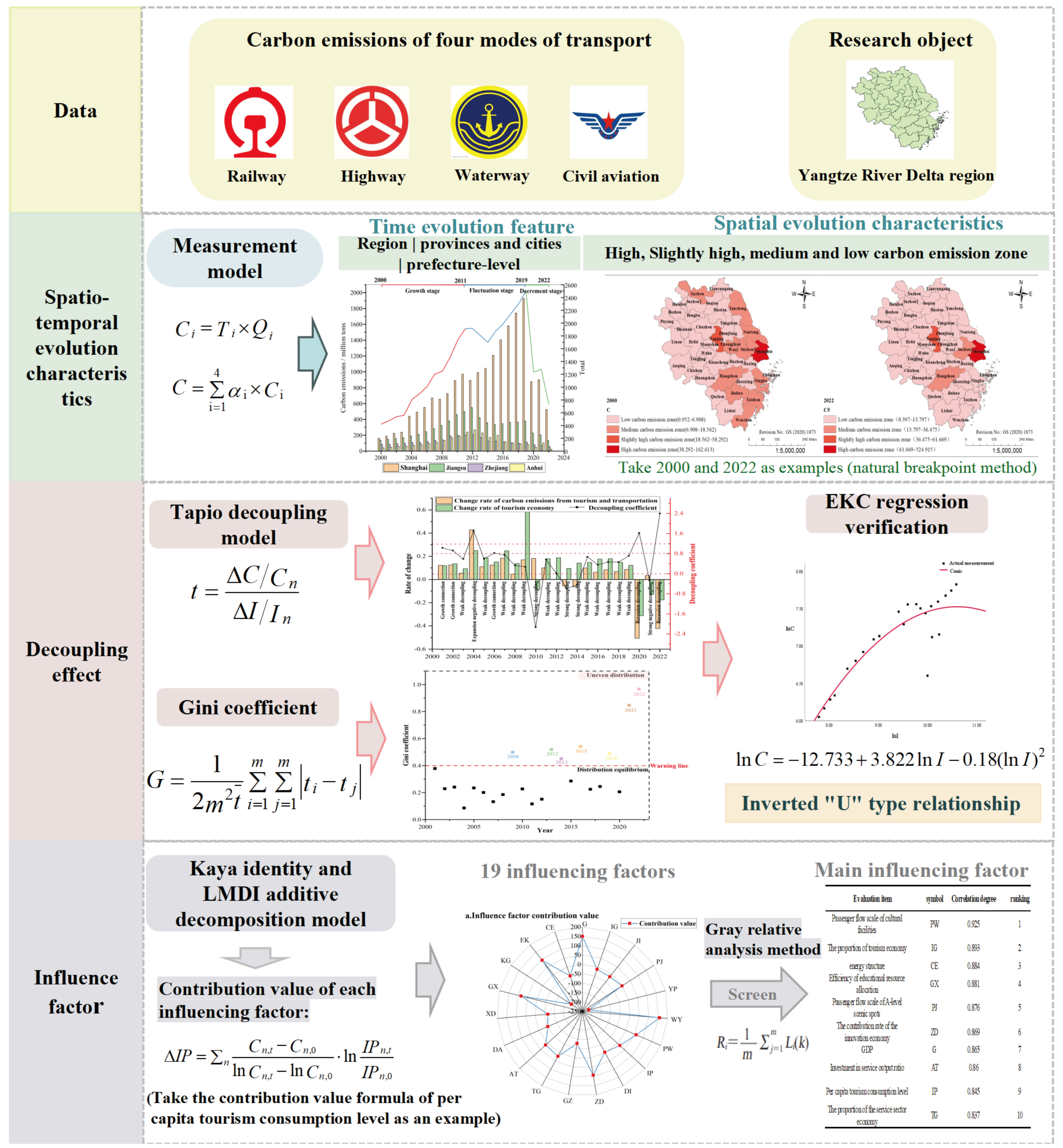

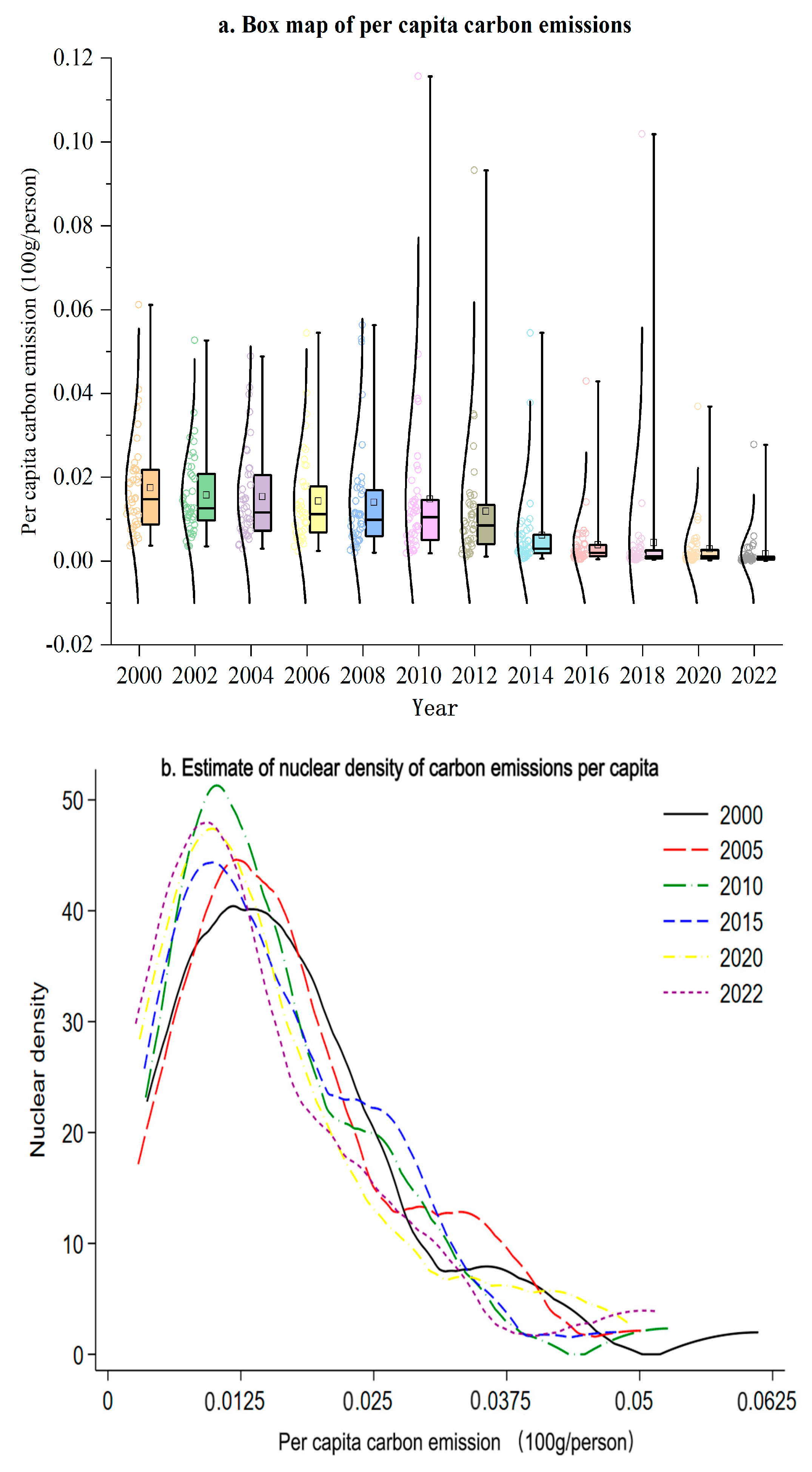
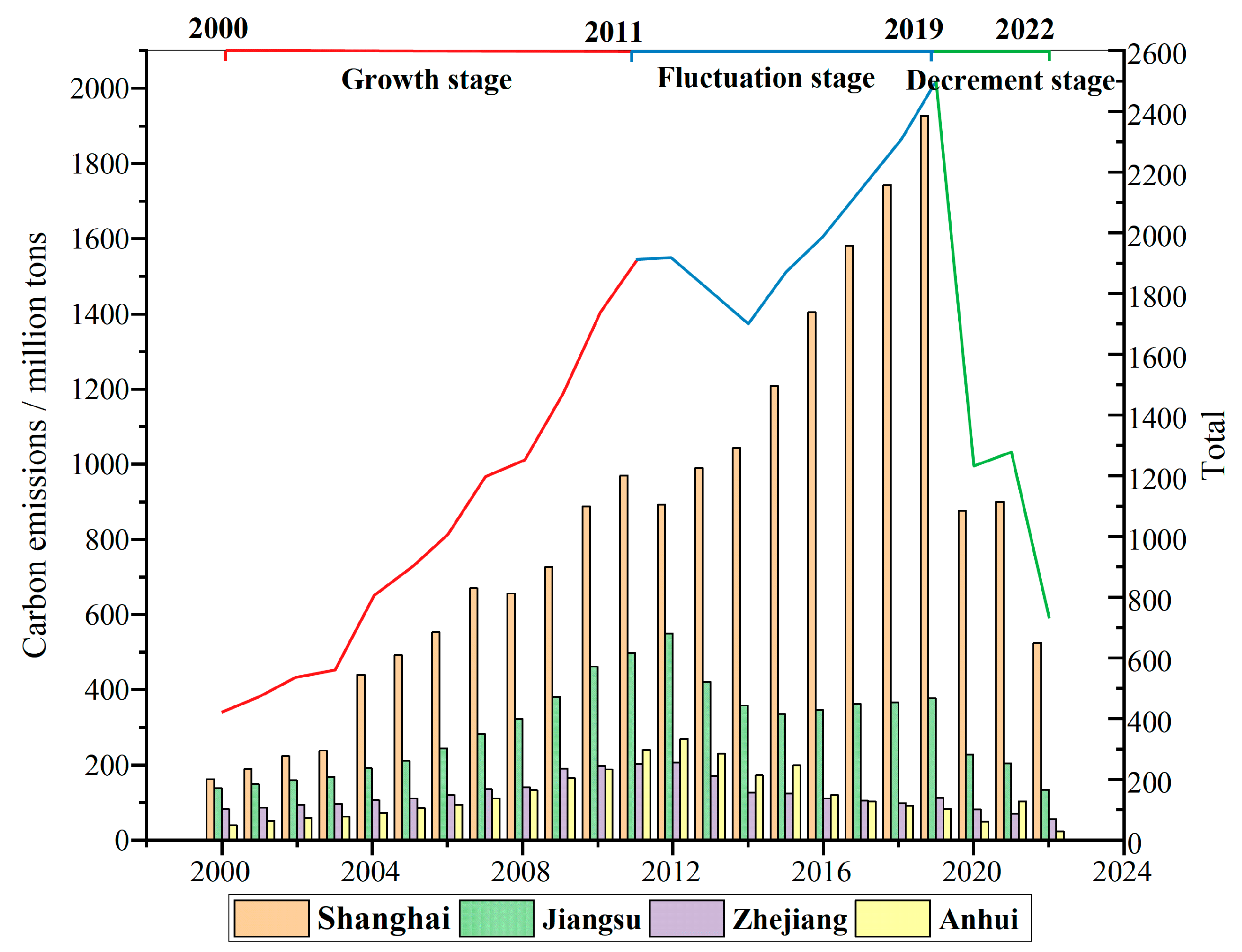
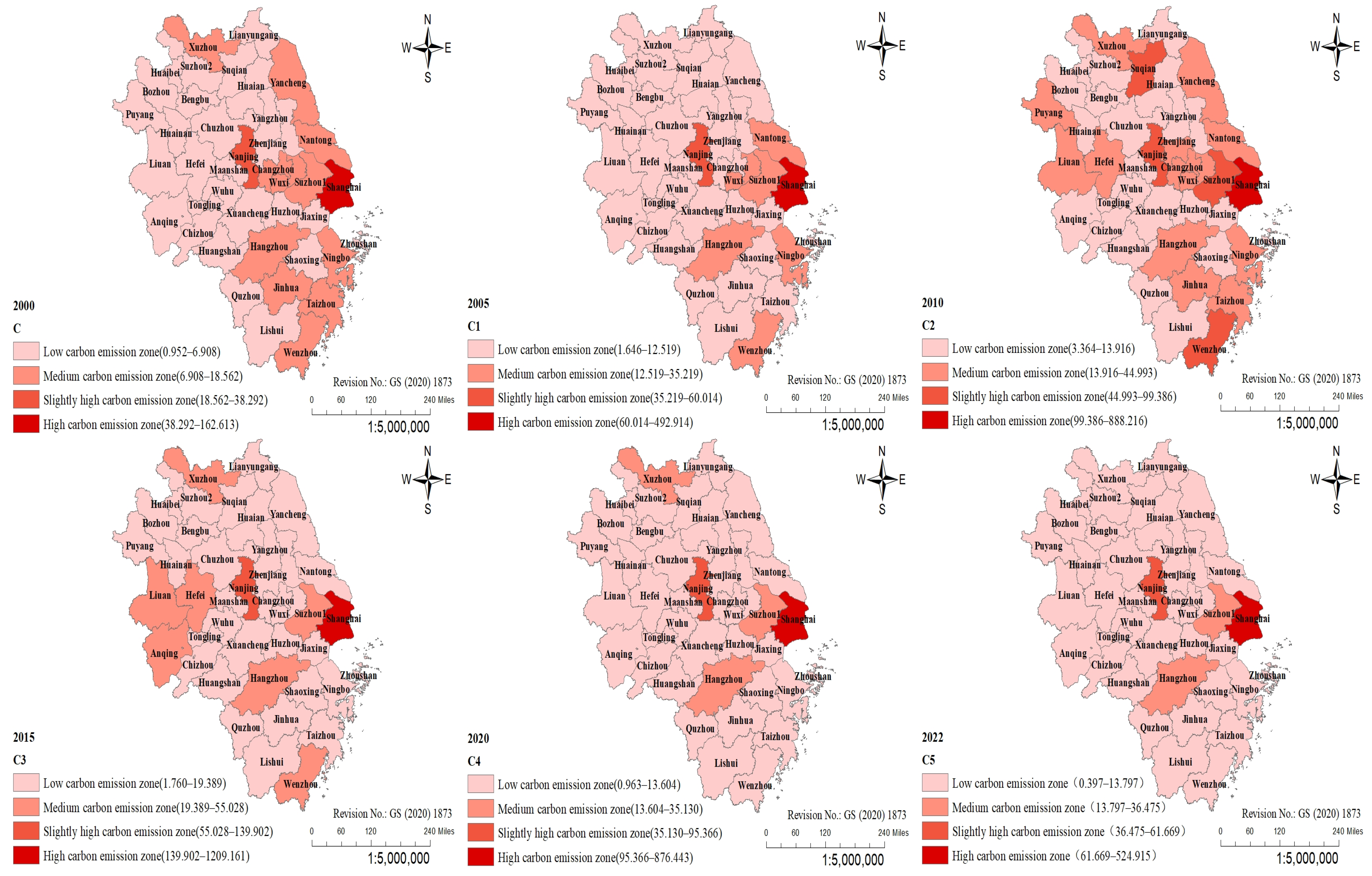

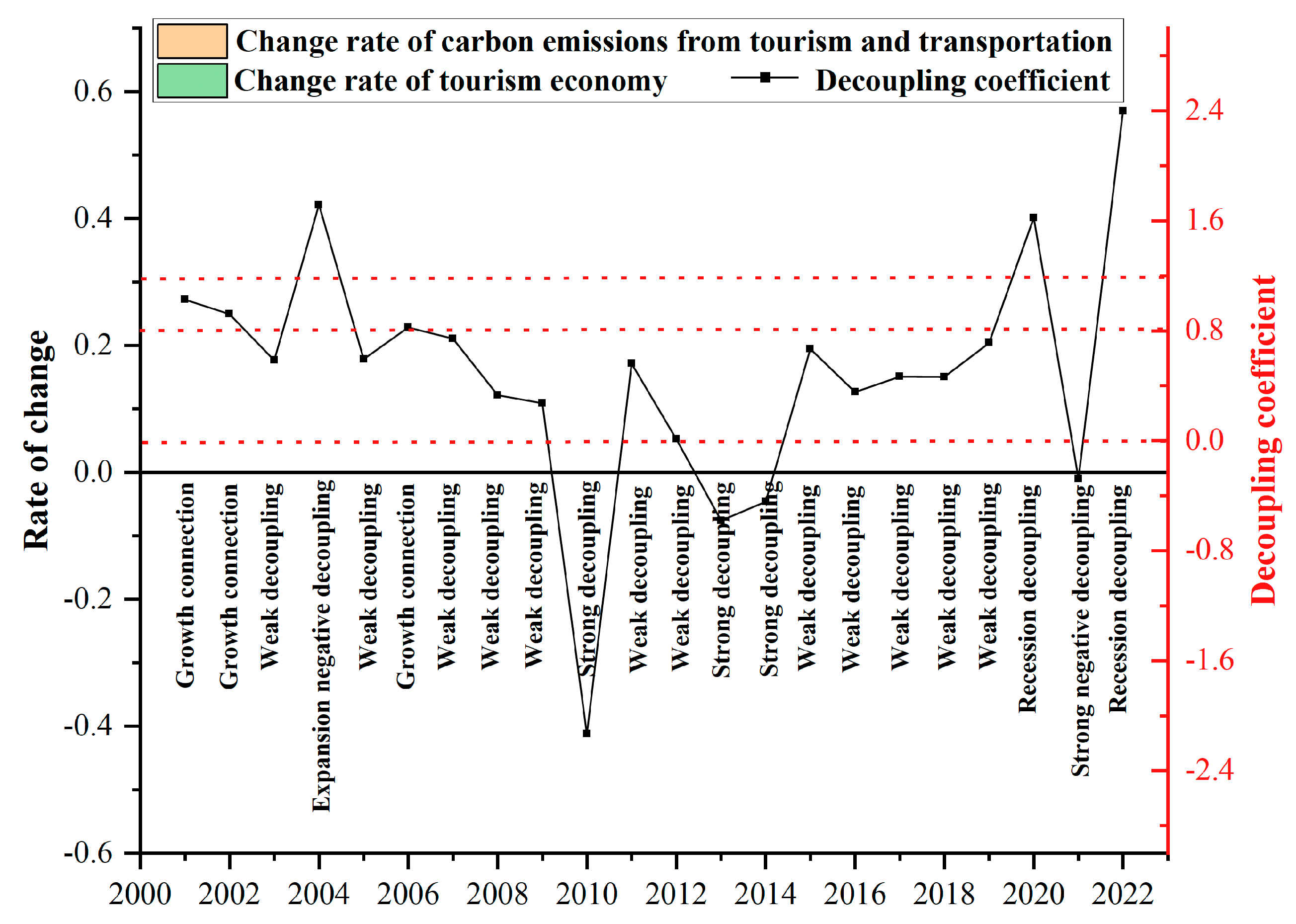
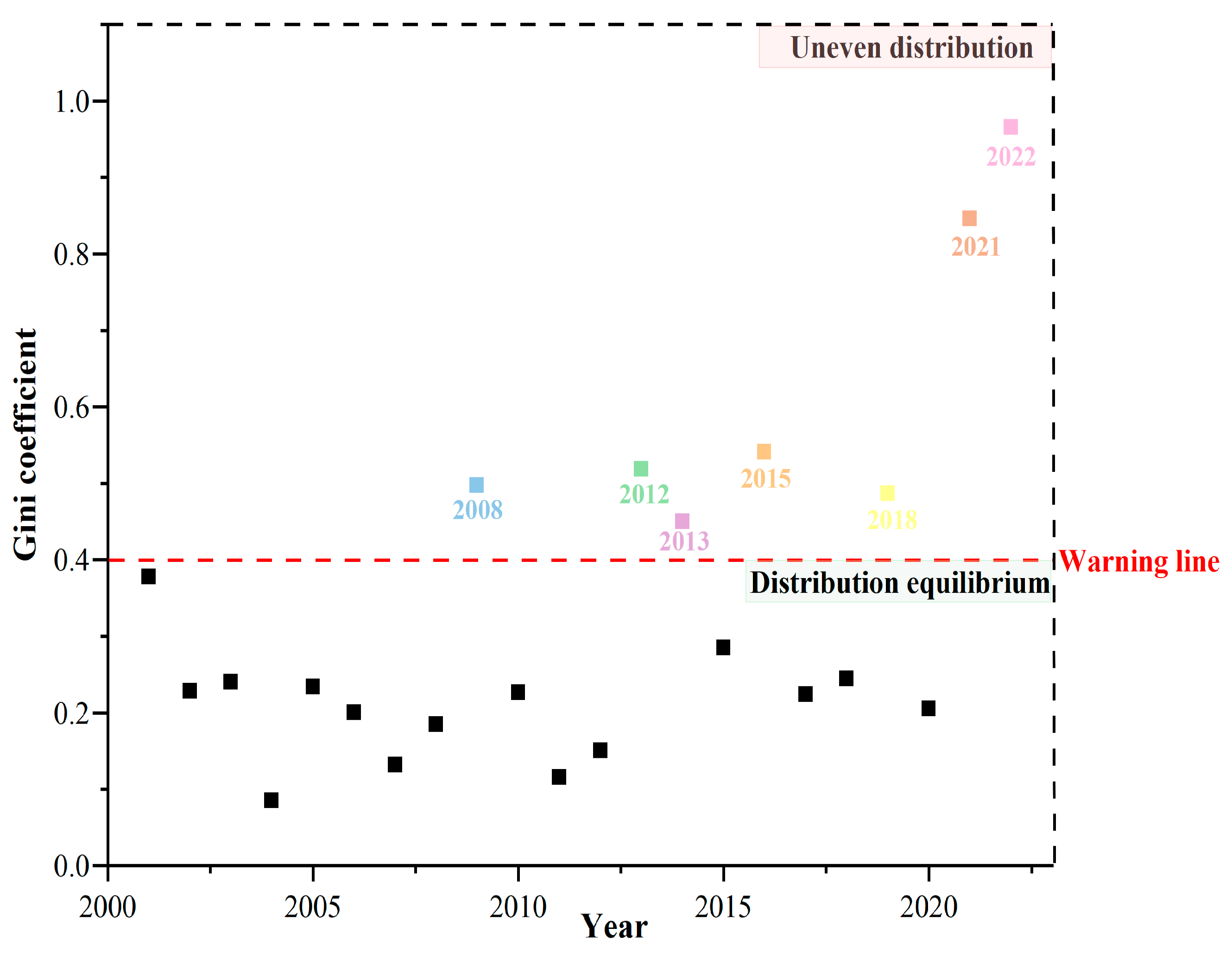
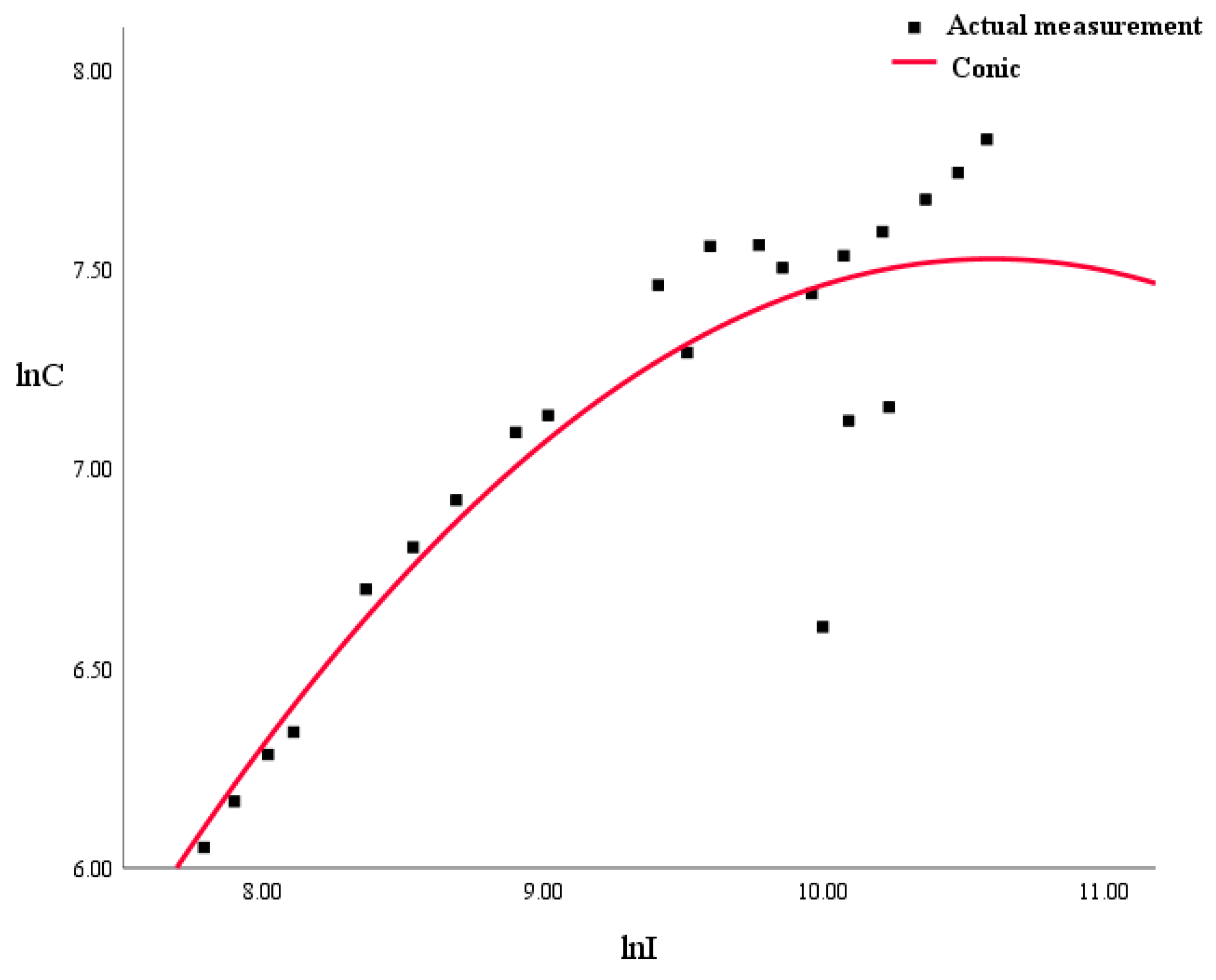
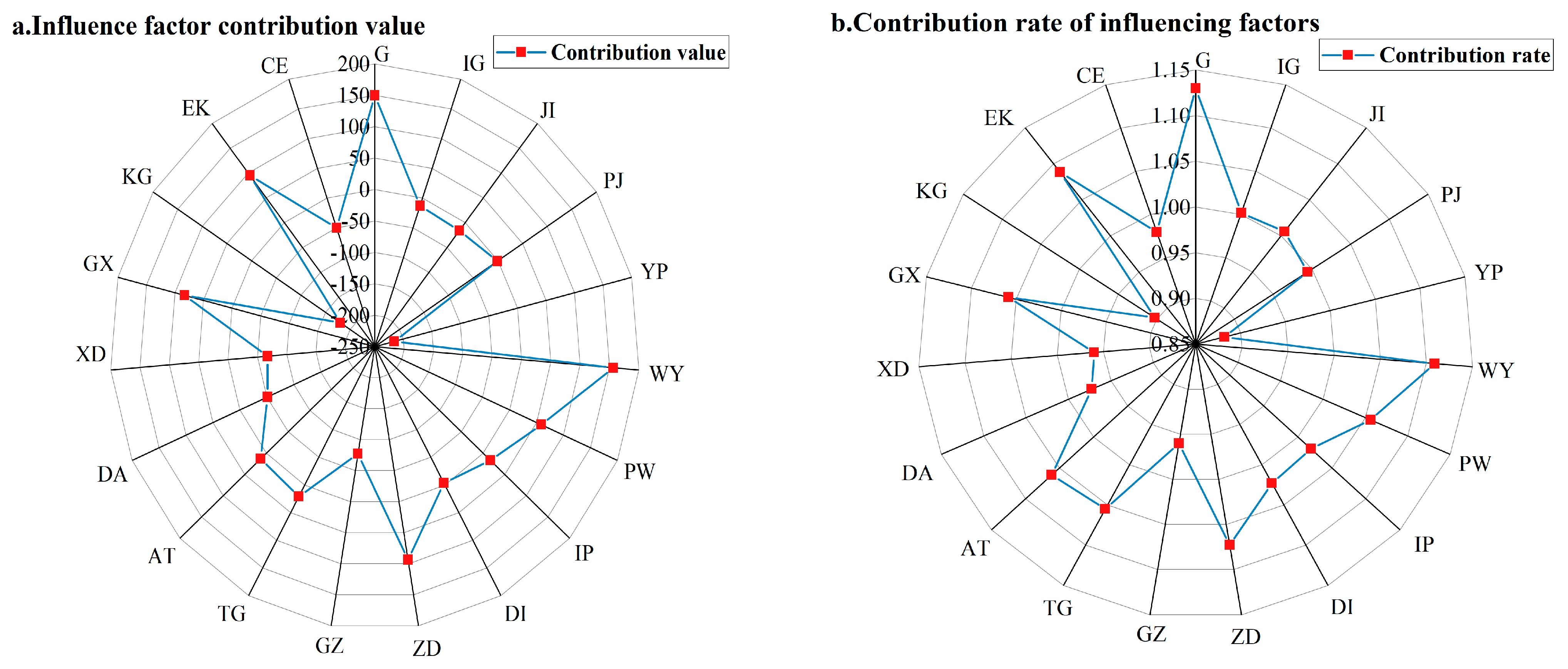
| Research Results | Railway | Highway | Civil Aviation | Waterway | |
|---|---|---|---|---|---|
| Global dimension | UNWTO-UNEP-WMO [6] | 27 | 133 | 137 | 66 |
| Country level | China [26] | 27 | 133 | 137 | 106 |
| Europe [27] | 27 | 133 | 137 | 66 | |
| Regional level | Yangtze River economic belt [8] | 27 | 133 | 137 | 106 |
| Five northwestern provinces [28] | 27 | 133 | 137 | - | |
| Six central provinces [29] | 27 | 133 | 137 | 106 | |
| Provincial and municipal level | Shanghai [20] | 27 | 133 | 137 | 106 |
| Hainan [30] | 27 | 133 | 137 | 106 | |
| Anhui [31] | 27 | 133 | 137 | 66 | |
| Shandong [32] | 65 | 132 | 396 | 66 | |
| Jiangsu [33] | 27 | 133 | 137 | 106 | |
| Jiangxi [34] | 65 | 132 | 396 | 66 | |
| Henan [35] | 27 | 133 | 137 | 66 | |
| Period | ||||
|---|---|---|---|---|
| Railway | Highway | Civil Aviation | Waterway | |
| 2000–2008 | 31.6 | 13.8 | 64.7 | 10.6 |
| 2009–2014 | 36.9 | 16.7 | 60.4 | 7.1 |
| 2015–2019 | 38.7 | 17.5 | 59.1 | 5.8 |
| 2020–2022 | 43.9 | 21.3 | 50.6 | 5.2 |
| Index | Number of Articles | Examples | Symbols |
|---|---|---|---|
| GDP | 240 | [41,42] | G |
| Tourism revenue | 157 | [43] | I |
| Ridership | 104 | [44] | Y |
| Number of visitors | 75 | [26,45] | P |
| Number of A-level tourist attractions | 57 | [46] | Q |
| The volume of passenger turnover | 55 | [41] | K |
| Value added of tertiary industry | 52 | [47] | T |
| Value added of the secondary industry | 39 | [48] | D |
| Investment in fixed assets completed | 20 | [49] | A |
| Number of cultural facilities | 34 | [50] | W |
| Number of patents granted | 11 | [51] | Z |
| Transportation energy consumption | 36 | [42] | E |
| Number of college students per 10,000 people | 9 | [52] | X |
| Bedding Plane | Indicator | Symbol | Variation |
|---|---|---|---|
| Visitor size | Per capita tourism consumption level | IP | |
| Travel ratio | YP | ||
| The scale of passenger flow in A-class scenic spots | PJ | ||
| The scale of tourist flow of cultural facilities | PW | ||
| Level of economic development | Gross Domestic Product | G | |
| Proportion of tourism economy | IG | ||
| Economic share of services | TG | ||
| Passenger turnover economic intensity ratio | KG | ||
| Value-added tourism contribution ratio of secondary industry | DI | ||
| Energy intensity | Passenger-turnover energy ratio | EK | |
| Energy mix | CE | ||
| New quality productivity | Efficiency of educational resource allocation | GX | |
| Production education ratio index | XD | ||
| Investment-output ratio | GZ | ||
| The contribution rate of the Innovation economy | ZD | ||
| Value-added ratio of production and investment | DA | ||
| Investment service-output ratio | AT | ||
| Infrastructure | Utilization rate of cultural facilities | WY | |
| Yield ratio | JI |
| Test Sequence | Unit Root Test | Cointegration Test | |||||
|---|---|---|---|---|---|---|---|
| t | p-Value | Conclusion | p-Value | Statistics | Result | ||
| Original time -series data | −1.888 | 0.3377 | Uneven | _ | |||
| −2.115 | 0.2385 | Uneven | |||||
| −1.877 | 0.343 | Uneven | |||||
| −1.684 | 0.4395 | Uneven | |||||
| First difference sequence number | −3.331 | 0.0136 | Smooth | 0.0104 | −3.416 | Smooth (5%) | |
| −3.072 | 0.0287 | Smooth | |||||
| −3.063 | 0.0294 | Smooth | |||||
| −3.045 | 0.0309 | Smooth | |||||
| Optimal Lag Order | ||||||
|---|---|---|---|---|---|---|
| Chi-Square Statistics | p-Value | Results | Chi-Square Statistics | p-Value | Results | |
| 1 | 4.4227 | 0.035 | Reject null hypothesis | 7.2952 | 0.007 | Reject null hypothesis |
| Evaluation Items | Symbols | Relevancy | Ranking |
|---|---|---|---|
| The scale of tourist flow of cultural facilities | PW | 0.925 | 1 |
| Proportion of tourism economy | IG | 0.893 | 2 |
| Energy mix | CE | 0.884 | 3 |
| Efficiency of educational resource allocation | GX | 0.881 | 4 |
| The scale of passenger flow in A-class scenic spots | PJ | 0.876 | 5 |
| The contribution rate of the innovation economy | ZD | 0.869 | 6 |
| Gross Domestic Product | G | 0.865 | 7 |
| Investment service-output ratio | AT | 0.86 | 8 |
| Per capita tourism consumption level | IP | 0.845 | 9 |
| Economic share of services | TG | 0.837 | 10 |
| Passenger-turnover energy ratio | EK | 0.797 | 11 |
| Value-added ratio of production and investment | DA | 0.786 | 12 |
| Yield ratio | JI | 0.783 | 13 |
| Value-added tourism contribution ratio of secondary industry | DI | 0.778 | 14 |
| Utilization rate of cultural facilities | WY | 0.771 | 15 |
| Production education ratio index | XD | 0.751 | 16 |
| Passenger turnover economic intensity ratio | KG | 0.734 | 17 |
| Investment-output ratio | GZ | 0.73 | 18 |
| Travel ratio | YP | 0.689 | 19 |
Disclaimer/Publisher’s Note: The statements, opinions and data contained in all publications are solely those of the individual author(s) and contributor(s) and not of MDPI and/or the editor(s). MDPI and/or the editor(s) disclaim responsibility for any injury to people or property resulting from any ideas, methods, instructions or products referred to in the content. |
© 2025 by the authors. Licensee MDPI, Basel, Switzerland. This article is an open access article distributed under the terms and conditions of the Creative Commons Attribution (CC BY) license (https://creativecommons.org/licenses/by/4.0/).
Share and Cite
Feng, D.; Li, C.; Deng, S. Study on the Decoupling Effect and Driving Factors of Tourism Transportation Carbon Emissions in the Yangtze River Delta Region. Sustainability 2025, 17, 3056. https://doi.org/10.3390/su17073056
Feng D, Li C, Deng S. Study on the Decoupling Effect and Driving Factors of Tourism Transportation Carbon Emissions in the Yangtze River Delta Region. Sustainability. 2025; 17(7):3056. https://doi.org/10.3390/su17073056
Chicago/Turabian StyleFeng, Dongni, Cheng Li, and Shiguo Deng. 2025. "Study on the Decoupling Effect and Driving Factors of Tourism Transportation Carbon Emissions in the Yangtze River Delta Region" Sustainability 17, no. 7: 3056. https://doi.org/10.3390/su17073056
APA StyleFeng, D., Li, C., & Deng, S. (2025). Study on the Decoupling Effect and Driving Factors of Tourism Transportation Carbon Emissions in the Yangtze River Delta Region. Sustainability, 17(7), 3056. https://doi.org/10.3390/su17073056





